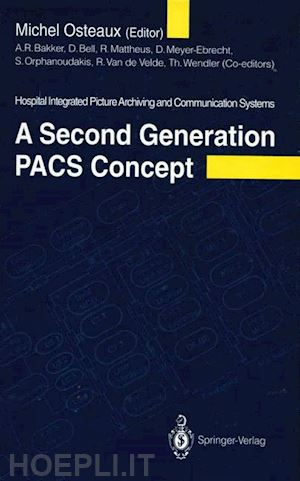1 Introduction, Definition, and Historical Background of Picture Archiving and Communication Systems.- 1.1 Background.- 1.2 Description.- 1.2.1 Image Entry.- 1.2.2 Communication.- 1.2.3 Storage.- 1.2.4 Data Compression.- 1.2.5 Presentation.- 1.2.6 Data Base Management.- 1.2.7 Organization and Procedures.- 1.3 Genesis.- 1.4 PACS Research.- 1.4.1 Workstations.- 1.4.2 Storage Devices.- 1.4.3 Network.- 1.4.4 Teleradiology.- 1.4.5 System Integration.- 1.4.6 Standardization.- 1.4.7 Diagnostic Image Quality.- 1.4.8 Technology Assessment.- 1.4.9 PACS Manufacturers.- 1.5 Clinical Implementation and Evaluation.- 1.6 Organizations and Conferences.- 1.6.1 Organizations.- 1.6.2 Conferences.- References.- 2 Medical Requirements for Clinical Integration.- 2.1 Introduction.- 2.1.1 The Clinical Advantages of PACS Technology.- 2.2 The Structure of Imaging Activities Within the Hospital.- 2.2.1 Some Definitions: Radiology, Diagnostic Imaging, Medical Imaging, Microscopy, Endoscopy.- 2.2.2 The Relationship Between Hospital and Its Diagnostic Imaging Activity: The AZ-Vrije Universiteit Brussels as a Case Study.- 2.2.3 Flow of Images Produced by the Radiology Department.- 2.2.4 The Different User Clusters of Diagnostic Imaging and Their Specific Needs.- 2.3 Medical Requirements in Terms of Access to Images.- 2.4 Medical Needs in Terms of Spatial Resolution.- 2.4.1 Spatial Resolution Required for Digital Thorax Radiology.- 2.4.2 Digital Skeletal Radiography.- 2.4.3 Digital Gastrointestinal Imaging.- 2.4.4 CT and MRI.- 2.4.5 Ultrasound.- 2.4.6 Conclusion.- 2.5 Medical Needs in Terms of User Friendliness.- 2.6 Medical Needs in Terms of Patient Data Consistency.- 2.7 Medical Need for Image Manipulation: Image Compression.- References.- 3 Looking for Indicators of a Reference Hospital.- 3.1 Introduction.- 3.2 Questionnaire.- 3.3 Basic Schema of Possible Indicators.- 3.4 Preliminary Results.- 3.4.1 Some Results for the Dutch Situation.- 3.4.2 First Steps Outside the Netherlands.- 3.5 Indications for Further Inquiries.- References.- 4 Communication Between Hospital and Radiology Information Systems and Picture Archiving and Communication Systems.- 4.1 Integrated Information Systems in the Hospital.- 4.1.1 Background.- 4.1.2 Computers in the Hospital: The Concept of HIS.- 4.1.3 Potential Benefits of HIS: Some Examples.- 4.1.4 Objectives of an HIS.- 4.1.5 Short History of HIS.- 4.1.6 Problems Encountered in HIS Realization.- 4.1.7 Approaches to HIS Realization.- 4.1.8 Realising HIS: Choosing an Approach.- 4.1.9 Common Characteristics of HIS.- 4.1.10 Structure of HIS.- 4.1.11 IMIA Working Group 10 “Hospital Information Systems”.- 4.1.12 Main Obstacles for the Further Development of HIS.- 4.1.13 HIS and Data Protection.- 4.1.14 HIS Workload: A Case Description.- 4.2 Radiology Information Systems.- 4.2.1 Introduction.- 4.2.2 PACS, HIS and RIS: Natural Couples.- 4.2.3 Radiology Information Systems.- 4.2.4 The Relationship of PACS to HIS.- 4.2.5 Distributed Radiology Systems: A Possible Architecture.- 4.3 Integration of PACS, RIS, and HIS.- 4.3.1 Introduction.- 4.3.2 Specifications of a Global HIPACS.- 4.3.3 Decomposition of HIPACS into its Components HIS, RIS, and PACS.- 4.3.4 Conclusions and Prospects for a Second Generation PACS Concept.- References.- 5 Networking.- 5.1 Image Network Technology.- 5.1.1 Introduction.- 5.1.2 Quantitative Requirements.- 5.1.3 Present State of LANs.- 5.1.4 Network Requirements for PACS Applications.- 5.1.5 ImNet: Specialized Image Network for PACS.- 5.2 Network Management.- 5.2.1 Why Network Management?.- 5.2.2 PACS Architecture.- 5.2.3 PACS Network Management Kernel.- 5.2.4 Network Model.- 5.2.5 Traffic Manager.- 5.2.6 Flow Manager.- 5.2.7 Simulator.- 5.2.8 Case Study AZ-VUB.- 5.2.9 Conclusion.- 5.3 Potential Benefits and Critical Issues of Prefetching.- 5.3.1 Introduction.- 5.3.2 A Model of Prefetching.- 5.3.3 The Algorithm and its Effectiveness.- 5.3.4 Pilot Study of Potential Effectiveness in Leiden University Hospital.- 5.3.5 Design of the Prefetch Component.- 5.3.6 Suggestions for the Second Generation of PACS.- References.- 6 Digital Image Workstations.- 6.1 Workstation Design Considerations.- 6.1.1 User Interfaces to Picture Archiving and Communication Systems.- 6.1.2 Workstation Design in the Transition to Fully Digital Imaging Departments.- 6.1.3 Methodology for the Design of User-Friendly Digital Image Workstations.- 6.1.4 Elements of Image Workstation User Interfaces.- 6.1.5 Technical Design Considerations.- 6.2 Adaptive User Interfaces for PACS Image Workstations.- 6.2.1 Why Adaptive User Interfaces?.- 6.2.2 State of the Art in Adaptive User Interface Design.- 6.2.3 Scenario for Adaptive, Co-operative PACS Workstations.- 6.2.4 Sources of Evidence for the Adaptation Process.- 6.2.5 Context-Sensitive Models of Diagnostic Information Requirements.- 6.2.6 Architectures for Implementing Adaptive PACS Workstations.- 6.2.7 Discussion and Perspective for Future Work.- 6.2.8 Acknowledgement.- References.- 7 Data Bases.- 7.1 Distributed Multimedia Data Base Systems.- 7.1.1 Introduction.- 7.1.2 Starting Point.- 7.1.3 Multimedia Data Bases.- 7.1.4 An Architecture for MMIP.- 7.1.5 Linking HIS and Image Data Bases Using These Architectures.- 7.1.6 Open Issues of Working Systems.- 7.2 Distributed Image Archival.- 7.2.1 Introduction.- 7.2.2 Analysis of the Current Situation.- 7.2.3 A Generic Concept for Distributed Digital Image Archives.- 7.3 Image Indexing by Content.- 7.3.1 Introduction.- 7.3.2 Image Representation.- 7.3.3 The Object-Oriented Approach.- 7.3.4 Image Retrieval.- 7.3.5 Description of the System Model.- 7.3.6 Evaluation.- 7.3.7 Possible Enhancements of the System.- 7.3.8 Conclusions.- References.- 8 Standardization.- 8.1 Trends.- 8.1.1 The Information Technology Industry.- 8.1.2 The Need for Standards.- 8.1.3 Open System Approach.- 8.1.4 Functional Profiles.- 8.1.5 Key Elements for Standardization.- 8.1.6 Decomposition of the Imaging Standard.- 8.2 Formal European Standardization Bodies.- 8.2.1 CEN/CENELEC.- 8.2.2 CENTC 251: Medical Informatics.- 8.3 European Bodies Promoting Standardization.- 8.3.1 European Workshop for Open Systems.- 8.3.2 X/Open.- 8.3.3 European Community Framework Programme.- 8.3.4 European Committee for Recommendations and Standards in Computer Aspects in Diagnostic Imaging.- 8.3.5 European Co-operation in the Field of Scientific and Technical Research.- 8.4 Standardization Actions Related to Medical Informatics and Imaging.- 8.4.1 Food and Drug Administration.- 8.4.2 American National Standardization Institute.- 8.4.3 Medical Data Interchange Committee.- 8.4.4 American Society for Testing and Materials E31 Committee.- 8.4.5 Health Level Seven Group.- 8.4.6 Open Document Architecture.- 8.4.7 EDIFACT.- 8.5 Standardization Actions for Medical Image Interchange.- 8.5.1 ACR/NEMA.- 8.5.2 Medical Image Processing System RC 109.- 8.5.3 Image Save and Carry Committee.- 8.5.4 Standard Product Interconnect.- 8.6 Conclusion.- References.- 9 Second Generation PACS Concept: A Global View.- 9.1 The First Generation PACS: Reasons for Their Failure.- 9.2 The New Generation: Medically Determined PACS Concept.- 9.3 Adaptive User Interface.- 9.4 Distributed Data Base.- 9.5 Integrated PACS/HIS/RIS Environment.- 9.6 Prefetching.- 9.7 Intelligent Distribution of Images: Knowledge-Based Networking.- 9.8 Modular Architecture; Phased Approach.- 9.9 Conclusion.











